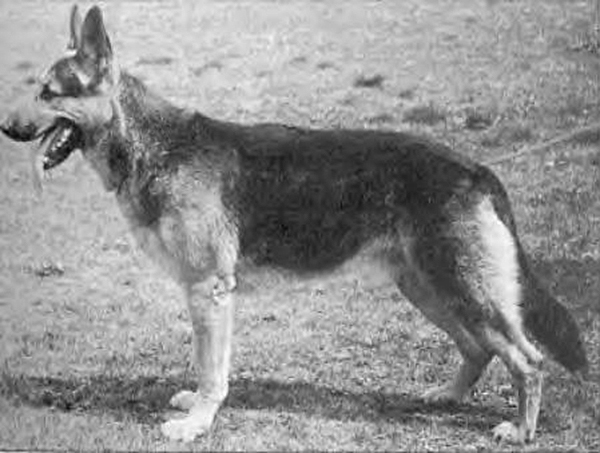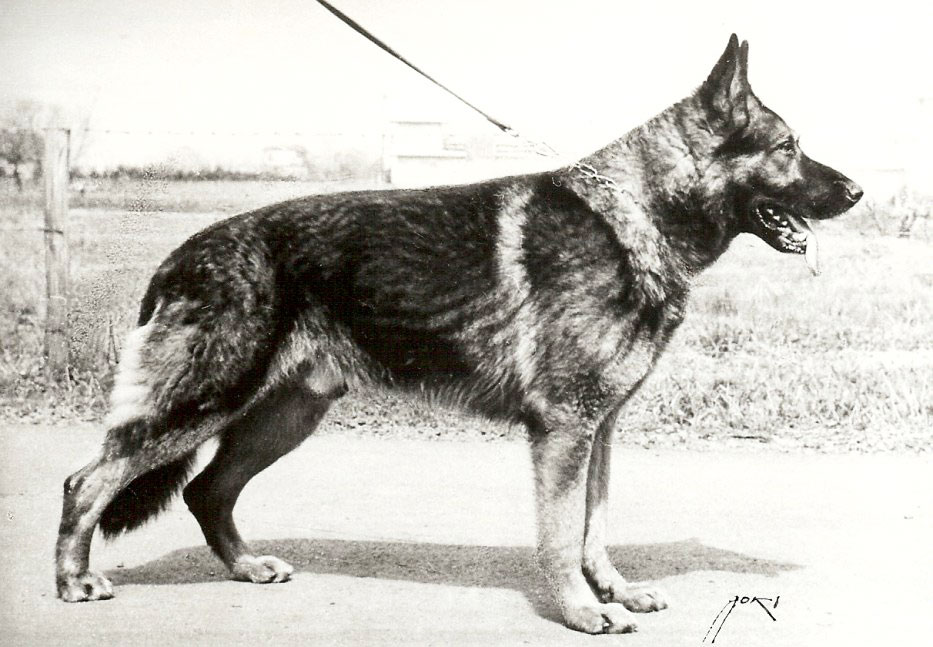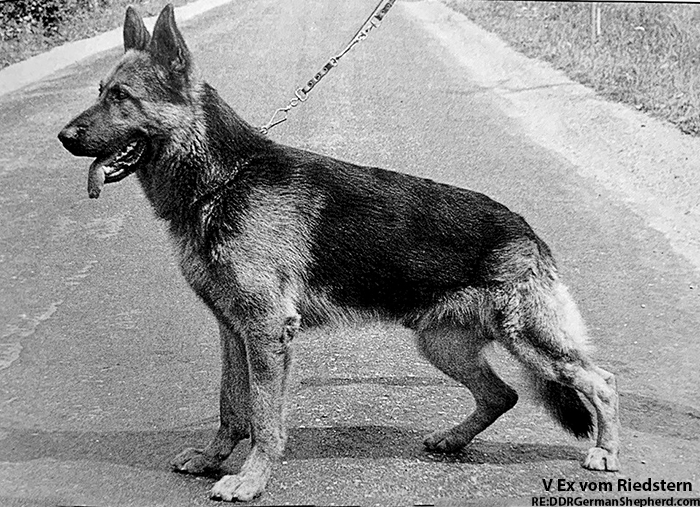DDR Working Class Males 1972- Judge: Werner Dalm
The competition of father males at the main breed show in 1972 within the GDR Winner Exhibition is over again. The number of around 60 males in this class is not high. Judging is pleasant without having to rush with the times, but from the point of view of what we want to offer our breeders and spectators, it could have been more.
At this point, we must once again appeal to all exhibitors to absolutely adhere to the specified deadline for this most important breeding show of the year, for which there are no late registrations. In addition, it is justified to advise breeders to to select their desired stud dogs for the upcoming pairings of their bitches from the group of males who have faced the competition of the respective year in Leipzig.
You can best withstand the building-related comparison with the following young offspring, you determine the picture of the respective breeding status and demonstrate what we have achieved in the purpose of breeding successful father dogs. The males are also named in the judge’s report with their litter and full siblings, their previous overall inheritance is listed according to the latest status up to one day before the main breeding show, so that the males present here every year are the safest guarantee for our breeders from this aspect as well a successful mating.
The males not registered, maybe they have to shy away from the direct beauty comparison with their competitors, maybe the family and heredity evaluation in the judge’s report should also be avoided, but they are all forgotten.
Of course there are exceptions, positive exceptions among father dogs. The stud dog who has grown older, perhaps about to end his career, no longer necessarily has to compete with the younger or still in full bloom males in the ring but is an excellent sire, he will always make his way in breeding. In any case, it should be expressed that it should actually be a moral obligation of our dog owners to report to Leipzig if they want their dog to have a say in the matter.
Excellent sires are unfortunately still very few and far between, so that not many can afford to stay away for this reason. – as far as these have emerged. It should also be said to our exhibitors that although the sporting ambition for a place as far ahead as possible is good and beautiful, but as a consolation, it is also not the only thing that makes you win. Certainly it is to be valued highly when a male proves his beauty into old age, but for our breeding much more important than the form value is his heredity.
That is why a male who is in the middle ranking in breeding can definitely be a desirable partner, who is a sought-after type and can improve a lot to get as high a place as possible, but rather also to show the male again and again that he has a good constitution, can present himself fresh and spirited and is therefore still recommended for breeding.
If our dog owners and breeders embrace these ideas, we can certainly succeed in increasing the number of males in the next few years and thus make the overall picture even more impressive for our breeders and seekers. One can be very satisfied with the quality of the males presented. We have achieved a very good quality in the structure of our dogs and there is also a very good width at the top. It is not the case that one has to ask the breeders from one main breeding show to the next to improve this or that detail in the sheepdog building, such as the croup, the pastern, the position of the upper arm or other details.
To want to influence such sub-problems in breeding would mean to take something out of context. The anatomical and exterior structure of a dog breed can only be improved in a complex manner, because everything is strongly type-dependent. You can only call for improvements to such details if you no longer have any worries or problems in breeding. It is known that we unfortunately cannot yet say that about our breeding area, which will be discussed again later.
In the case of the type dependency of the physique just mentioned, it should be remembered that all domestic dog breeds can be traced back to two basic types after their skull formation: the heavier Decumanides type (mastiff’s heads) and the lighter Veltrid type (long skull). In addition to the anatomical differences in the skull, there are usually other features. The most important features of the former type are a chunky skull, pronounced rumpiness with rounded ribs, plenty of room for digestive organs, coarser bones, shorter extremities and shorter body processes.
The basic characteristics of the Veltride type are a slimmer build, a corresponding head, a flatter rib with a larger extension downwards, therefore more space for the respiratory organs, longer extremities and longer body processes. These two basic types correspond to the two metabolic types, the metabolic type or type of fattening, and the metabolic type or respiration type. To make the matter a little clearer, one could name the breeds St. Bernard, Newfoundland, Bernese Mountain Dog, Rottweiler and Great Dane breeds for the heavier type and the greyhound breeds, Dobermans and Collies for the slimmer type.
The substance batch types are so named because they primarily use the nutrients in the diet as body substance, meat and fat. The metabolic types utilize the nutrients offered mainly to provide energy for the various life functions, also as energy for work.
Now, for the sake of completeness, it is essential to mention that there are no completely pure types in any field.There are mixed and transition types between the two basic forms of the domestic dog skull, the Decumanides and the Veltrides, and there are also intermediate and UD types between the two metabolic types with their physical and physiological characteristics. In most cases, the two types of metabolism also speak of certain types of behavior, since the functions of the nervous system are also influenced by the metabolism also more choleric in his temperament. Of course, the mentioned mixed and intermediate types also relate to the nature of the situation, as the large number of observed behaviors of our dogs proves.
After this brief digression into the questions of ancestry and questions about functional types, let us come back to our German Shepherds. According to the anatomical details of its skull, the German Shepherd belongs more to the Veltride type. As a medium-sized and medium-weight dog breed, however, in terms of its overall appearance, it is in the middle of all the opposing domestic dog breeds. Since it is also characterized by great variability, it is in the middle between the two extremes with their most important ones with regard to the metabolic types physical characteristics, so within our race we have families and lofts that are more inclined to the heavier type of material turnover, as well as those that show more the more elegant type of material turnover.
Of course there are also all transition types in between. The long-time connoisseur of our breed could be an example of the heavier type Fero aus der Eselstadt, Ali v. Silberbrunnen, Cello v. Hof Argied. As a representative of the not so compact type Utz vh Hiller, Dux v. d. Fliehburg, Aris v. d. Kohlsdorfer Höhe, Tell v. Vogelhaus. The circle of considerations comes full circle when we come back to the level of building improvement achieved in the last two years. Undoubtedly, the GDR winner in 1971 and 1972 also belongs more to the type of substance turnover that was impressed on him by his father, who for his part is a very typical representative of this direction.
A few years ago we had to find out that we would have liked a firmer topline across the width of our dogs. Well, a firm back doesn’t just depend on proper rearing. It is inherited to a large extent because it is anatomically dependent on the length of the spinous processes on the individual vertebrae, because these offer a broader attachment surface for tight back muscles. These desired long spinous processes are an example of when I said in the introduction that individual parts of the overall body structure are type-dependent. Among the main characteristics of the breathing type I mentioned, longer body processes, including the spinous processes of the spine.
That is why the “beautiful topline” that we admire so much depends on the type. With a-Ex v. Riedstern, the father of the now two-time GDR winner, we have undoubtedly achieved the breakthrough to this desired solid back line. However, it also has other typical characteristics of the turnover type, in the skull shape, which is strong enough but still has noble lines, in running bones of good length and thus also cheap, long lever arms and also in the flatter arched ribs and thereby lowering the chest. All these characteristics could also be ascribed to his son a-Condor vom Marderpfahl.
I mention this because our breeders need to be clear about the fact that we also have to accept something if, on the other hand, we are striving for advantages that are tied to a certain type. If the beautiful solid top line of the ex-family is to be further spread in our breeding, we will have to take the somewhat deeper chest, which offers space for the large respiratory organs, a necessity for a persistent working dog.
I do not consider this feature to be a disadvantage at all if it is combined with sufficiently long running bones, which in turn help a dog to get a good grip on the gait.
In short, I consider this type of Ex-Riedstern/Condor Marderpfahl for the next few years for the required and appropriate type that will help our breeding. It is particularly gratifying to mention that the winner has the Type and temperament he deserves and passes it on to his children. From various basic organizations in several districts there are unanimous opinions that Condor descendants are very temperamental and bite early out of a natural sharpness. A fact that makes us happy in the interest of further improving our being.
With regard to the good building quality of our dogs mentioned at the beginning, it should be mentioned that we do not have to orient our breeders to expressly improving the croup and hindquarters. beautiful “looks. This term is relative. What is useful is beautiful! For the most important working dog breed, this means that the inclination of the pelvis, the length and position of the lever arms of the hindquarters must be such that the dogs can walk with it for a long time, i.e. run economically, with as little wear and tear as possible. And there have long been practical observations that a slightly more inclined pelvis does not prevent a dog from running expansively and powerfully. The angulation of the hindquarters must not be developed in the direction that the angles in the knee and ankle get too deep, come close to over-angling.
Such a hindquarters would be unphysiological, directed against a normal and powerful function of the hindquarters. From the laws of statics alone it follows that the strength of a construction must decrease with increasing angulation. The step size, the powerful action, the correct sequence and the endurance are the criteria for whether a dog is “beautiful” in the hindquarters. If a normally to well-angled hindquarters meet these conditions, achieve the highest level of practicality, then it is just beautiful! Apart from these practical considerations of many years of shepherd dog observation and evaluation, scientific research also suggests that a less pronounced angled hindquarters in connection with a certain inclination of the pelvis creates more favorable tension and pressure conditions in the hip joint. So before we move on we should rather look at the perfecting of the forehand, a good sloping position of the shoulder, combined with a pronounced withers, influence and support the desired firm topline, the sloping shoulder must be joined by an upper arm of good length, both then make possible also the desired long advance when the power from the hindquarters is transmitted through a tightly muscled back.
To end my introductory considerations, I would like to briefly come back to the problems announced at the beginning, so that, despite all the joy about the beauty and harmony of our dogs presented in Leipzig, we do not forget the selection in the entire breed. It should constantly be the endeavor of all breeders and breeding-directing functionaries in the entire breadth of the population to strive to constantly reduce the known hereditary defects, the judges’ reports, licensing books, complete lists of the offspring assessments and other sources of information should be used again and again in order to learn as much as possible about the characteristics of the siblings of one’s own dog and about those of the desired stud dog.
Breeding partners should not only be chosen from the point of view of absolutely wanting to breed V-dogs, but mainly afterwards to avoid the inherited defects that are already in the family of the other partner. If we succeed in breeding a healthy breed with as little genetic damage as possible, we can again breed well-inheriting top dogs with much greater certainty, which combine beauty, performance, health and hereditary strength.
Werner Dalm, Main Breed Warden Stralsund, September 20, 1972



3 thoughts on “Werner Dalm Breed Warden GDR”